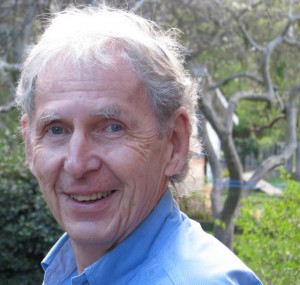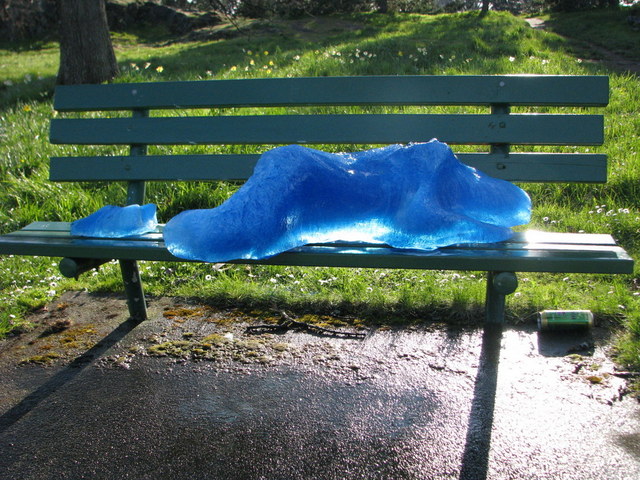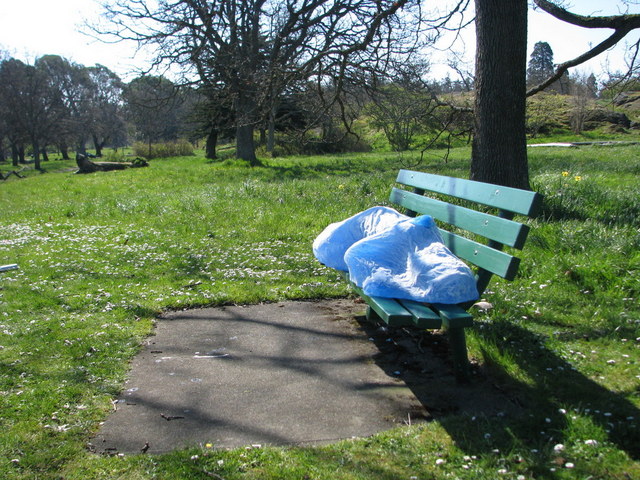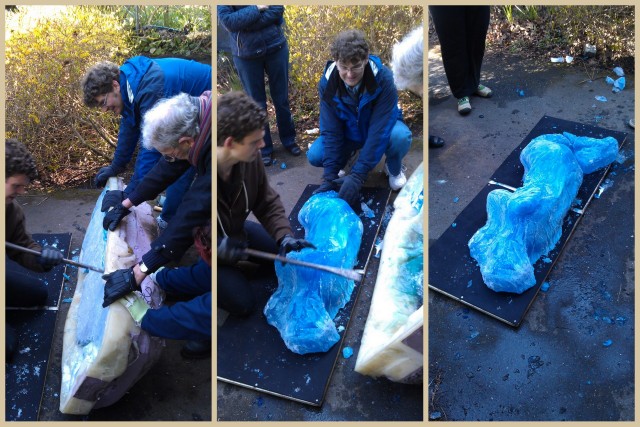Gorgeous, mysterious, eerie, disturbing, melancholy — look at the photos and read the essay by Jack Hodgins, eminent Canadian novelist, already a contributor to NC, and wonderful friend. The top three photos were taken by Jack’s son Tyler, the artist who conceived this project. He freezes live-sized ice images of sleeping homeless people and then cracks them out of the mold and trucks them to various locations around Victoria, British Columbia, where he lives. They melt, of course, or they get knocked off their park benches and break — one just disappeared the next day. There are two effects. One is political/social: the images are meant to draw attention to the plight of homeless people; do we really just wish them to disappear as the ice images do? The other effect is aesthetic: the beautiful, transitory, fleeting, evaporating image with the light describing strange and changing patterns through its translucent surface. The great purpose of art is to startle us into seeing something fresh and real. I look at these images and feel that telltale stirring in the back of my neck.
The second set of photos below show the work in progress — Jack Hodgins, the white-haired gent, and his three children, Tyler, the artist (in the brown jacket), Gavin and Shannon, fighting the blue homeless ice man out of his mold in Tyler’s driveway. (Other family members were standing just out of camera range. The photos were taken by Heidi, Tyler’s wife.) Given NC’s propensity to nepotism, this is a quintessential NC moment — the whole family making art together. It warms my ancient, shriveled, dessicated heart no end.
For a full explanation see www.tylerhodgins.ca. The entire project was sponsored by the Art Galley of Greater Victoria.
dg
Once we’d raised the homeless man from the freezer, a thin slick of whitish condensation began immediately to form on his bright blue surface. Like the others, he weighed nearly three hundred pounds, which meant that raising him had required a pair of sturdy straps and a chain pulley attached to the ceiling joists above.
He had frozen in the asleep-on-a-bench position, his knees pulled up, his head resting on his hands, though of course we could see this clearly only after my son had used a sturdy pry bar to free him from the thick rubber mould.
As soon as we’d shifted him onto a plywood stretcher, the four of us carried him across the driveway and slid him into the back of a borrowed van. Then we drove him down through town to the city’s main park, where we carried him across the grass, past a clump of blooming daffodils, and laid him out on a green slatted bench that looked out over the passing traffic. Those who came close enough would be able to see, in this light, the distinct track of the sleeping bag zipper this person had fallen asleep in.
Perhaps they would also notice that this person’s face is without features. He — or perhaps she — is essentially faceless.
Because the early-spring sun was weak that morning, there was a chance the frozen person would take a few days to melt entirely. Unless, that is, vandals attacked and dismembered him first, as had apparently been done to the previous week’s “Sleeping Bag.” Of course it was possible that someone with a powerful need to sit, or to rest her tired legs, would push him off the end of the bench and onto the long grass, where he would continue the process of melting in two or three separate pieces.
Of course a few passers-by slowed, and muttered amongst themselves, but did not come close, and moved on as soon as they were aware of being noticed. Only a child came up close enough to examine, perhaps to marvel. He did not say what he was thinking. We couldn’t hear what he reported to his grandmother, who remained at a distance. Clearly it was time for us to leave this blue person to sleep in peace and the city residents to observe or ignore as they pleased.
We all knew, though we hadn’t yet said it aloud, that we would find an excuse to drive by and check on “our frozen one,” our own “Sleeping Bag” the following day.
Most of our son’s successful public art works have been large structures of stainless steel, made to last “forever.” In contrast, none of the ice persons set out on a bench each Saturday for thirteen weeks has lasted more than a day or so. One had been moved down to sit in a puddle, gradually turning the muddy water blue; an orange one had almost certainly been tossed into the harbour, and another had disappeared altogether after little more than an hour. (Taken home perhaps? A trophy in the family freezer, a joke, to shock someone sent downstairs to bring up a roast?) That they vanished so quickly — melting or otherwise — is a reminder of our ability to allow the breathing homeless amongst us to fade rapidly from our awareness and altogether disappear.
*
The project was sponsored by the Art Gallery of Greater Victoria, encouraged by the city’s Coalition to End Homelessness, the Community Social Planning Council, and The Centre for Addiction Research of BC — and permitted by the city council. Ironically, though the city’s permit was for benches only (for safety reasons), the living breathing homeless would be arrested if they were to stretch out to sleep on those same benches, day or night.
Different friends or relatives were invited to help move and install “Sleeping Bag” for each of the thirteen Saturdays. This had been the immediate family’s turn. Apparently each crew had had its own way of reacting to the job. I’m fairly certain that most felt a little as though they were participating in something sombre, very much like a funeral, though there was also good reason for considering this a setting free, a rescue, even a sort of resurrection. And this was spring after all, and Easter weekend – our turn chosen for when all members of the family would be in town.
—Jack Hodgins
——————————-
 Jack Hodgins’s novels and story collections include: Spit Delaney’s Island, The Invention of the World, InnocentCities, Broken Ground, and Damage Done by the Storm, amongst others. A Passion for Narrative (a guide to writing fiction) is used in classrooms and writing groups across Canada and Australia. His fiction has won the Governor General’s Award, the Canada-Australia Prize, and the Ethel Wilson Fiction Prize, the Butler Book Award amongst others. He has given readings, talks, and workshops in Australia, New Zealand, Japan, and several European countries. In 2006 he was awarded both the Terasen Lifetime Achievement Award and the Lieutenant Governor’s Award for Literary Excellence in British Columbia. In 2010 the Governor General awarded him an Order of Canada. He and his wife Dianne live in Victoria where, until recently, Hodgins taught the writing of fiction at the University of Victoria. His latest novel, The Master of Happy Endings was published in 2010. His website: www.jackhodgins.ca
Jack Hodgins’s novels and story collections include: Spit Delaney’s Island, The Invention of the World, InnocentCities, Broken Ground, and Damage Done by the Storm, amongst others. A Passion for Narrative (a guide to writing fiction) is used in classrooms and writing groups across Canada and Australia. His fiction has won the Governor General’s Award, the Canada-Australia Prize, and the Ethel Wilson Fiction Prize, the Butler Book Award amongst others. He has given readings, talks, and workshops in Australia, New Zealand, Japan, and several European countries. In 2006 he was awarded both the Terasen Lifetime Achievement Award and the Lieutenant Governor’s Award for Literary Excellence in British Columbia. In 2010 the Governor General awarded him an Order of Canada. He and his wife Dianne live in Victoria where, until recently, Hodgins taught the writing of fiction at the University of Victoria. His latest novel, The Master of Happy Endings was published in 2010. His website: www.jackhodgins.ca
Tyler Hodgins graduated in 1990 from The Victoria College of Art diploma program, and was made an Honorary Associate of the college in 1993. He has exhibited widely, and has work in public and private collections in Canada and the United States. He lives in Victoria with his wife and three children. Tyler’s work is primarily sculptural, and includes video, photography, installation works and public art. Studio based projects focus on themes of home, language, repetition/reproduction, and chance. In 1999 he was a member of the design team for public art on Broad Street in Victoria, and in 2009-2010 was on the steering committee for a new Public Art Policy for the City of Victoria. He has been short listed for numerous public art competitions, and has completed three public commissions, “Rings” for the District of Saanich, “Topography” for Victoria, and “Gateway” for the Gateway Theatre in Richmond. “Glass Half Full” will be completed for The City of Victoria during the summer of 2011. His website: www.tylerhodgins.ca





How amazingly wonderful this is–the art & its makers. Even the transition from steel to ice is beautiful. Thank you. Now I’m going to be ruthlessly scanning every single park bench for a flash of ice body whenever I’m in Victoria…
Fascinating and beautiful work! I love this poignant use of ice. It reminds me too of the homeless who freeze to death in our cold northern cities.
It truly is thought provoking art. As well as the freezing aspect, the melting is the symbol that touches me the most..the forgotten and invisible problem as each piece passes away.
Exquisite & poignant–and I’m especially struck by the juxtaposition of the cold loneliness of the homeless sleepers and the warmth of the family working on the project together….very moving. Thanks.